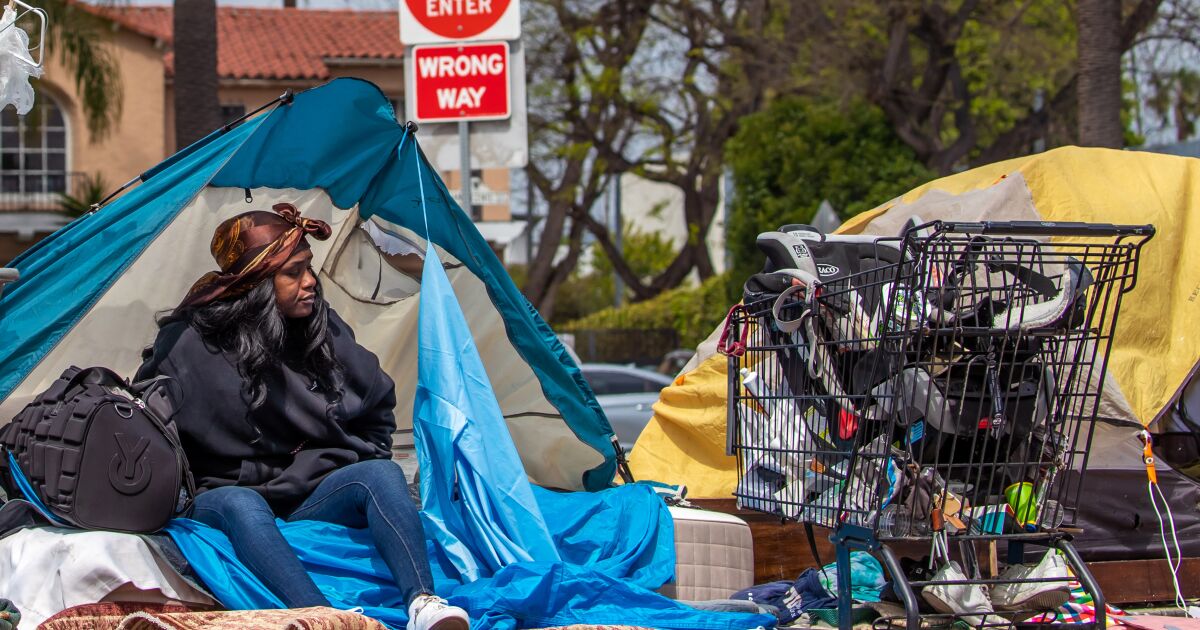Sidebar
Los Angeles
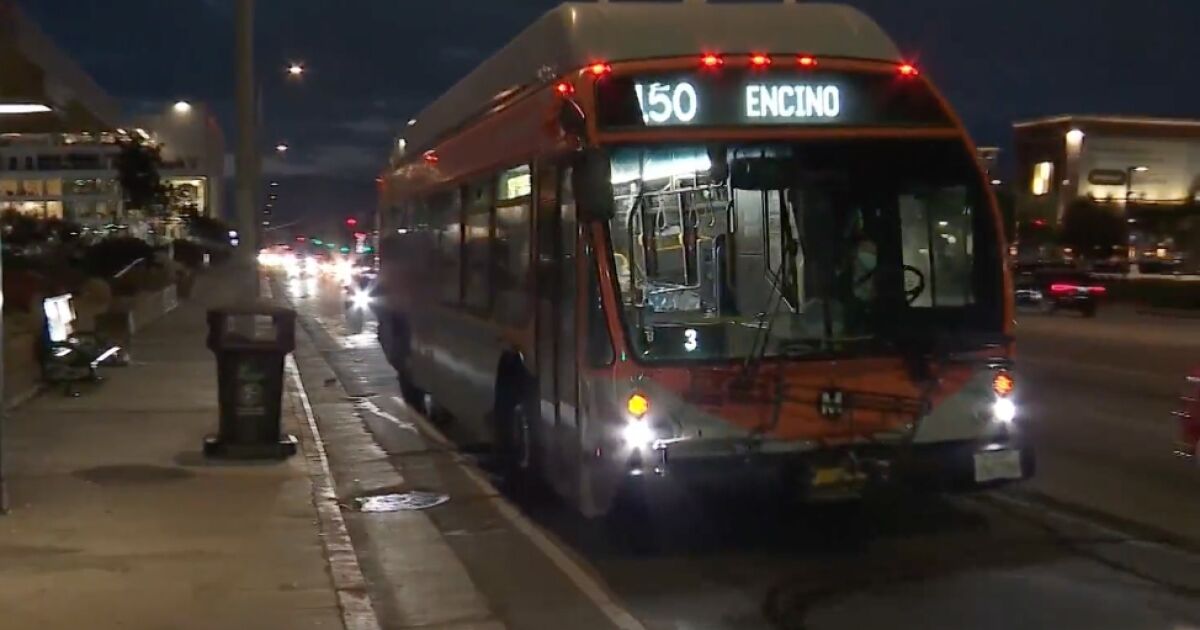 www.latimes.com
www.latimes.com
cross-posted from: https://lemmy.ml/post/1457493 > Los Angeles police have arrested a man suspected of stabbing a Metro bus driver Thursday afternoon in Venice. > > The driver was behind the wheel near Main Street and Venice Way around 2:15 p.m. when a man stabbed him in the back, according to police. > > The suspect then fled into a nearby business and was later detained by police, authorities said. The weapon was recovered by law enforcement > > The driver is in stable condition, according to the Los Angeles Police Department. > > “Metro is angered and saddened to hear about this heinous act of violence and is providing support to our employee and his loved ones,” Metropolitan Transportation Authority spokesman Dave Sotero said in a statement. “We will work closely with the LAPD to investigate this incident and are grateful for their swift action in arresting the suspect.” > > The assault is the second stabbing of a bus driver in a month: On May 24, a 61-year-old Metro driver suffered life-threatening injuries after he was stabbed by a 17-year-old boy over an argument about fare evasion. > > As The Times reported in May on the growing number of assaults against Metro bus drivers, the agency is attempting to curtail such incidents by installing floor-to-ceiling plastic walls that fully encase the driver. The barriers were being tested on about 20 buses. > > Subscribe to Continue Reading > > “We’re [trying] to mitigate the vulnerabilities that exist right now where a patron or someone doing the assault still has access to the operator,” said Robert Gummer, a Metro deputy executive officer. > > Anyone with information related to Thursday’s incident is asked to call the LAPD’s anonymous tip line at (877) 527-3247.
 www.latimes.com
www.latimes.com
cross-posted from: https://lemmy.ml/post/1449235 > Students and faculty at Jordan High School say they have spent decades complaining about harmful industrial operations next door to their Watts campus, but to little avail. > > Piles of scrap metal have towered over a 10-foot wall separating S&W Atlas Iron & Metal from the school’s blacktop basketball court, and the company’s operations have hurled shards of metal onto school grounds and dusted the campus in an iridescent shimmer of metals. > > Now, amid rising outrage from community members, L.A. County Dist. Atty. George Gascón has announced the filing of more than two dozen criminal charges against Atlas and its owners. > > At a Wednesday news conference at Jordan High School, Gascón said his prosecutors have charged Atlas, along with father-and-son owners Gary and Matthew Weisenberg, with 22 felonies and four misdemeanors. The criminal complaint alleges the scrapyard illegally disposed of hazardous materials, including brain-damaging lead, on at least five occasions between July 2020 and August 2022. > > The decision to charge company owners marks a rare prosecutorial action for an environmental crimes case, and reflects the severity of the accusations, Gascón said. > > “We believe that their conduct is egregious,” he told reporters. “We believe that they have consistently avoided and evaded facing the rules of law, and we think that they are personally liable.” > > Benjamin N. Gluck, an attorney representing the owners, said he still hadn’t learned the details of the charges. Gascón “declined to engage” with his clients and “chose instead to file charges,” he said. > > “We were disappointed to see the charges. Atlas is actively working with the many public agencies involved and is actually moving close to a global resolution.” > > An arrest warrant has been issued for the Weisenbergs, whose arraignment has been scheduled for Monday. They are expected to surrender to law enforcement before then, the D.A.’s office said. > > The bombshell prosecution follows a litany of separate enforcement actions against the facility. > > In recent years, the L.A. city attorney’s office and the California Department of Toxic Substances Control have each sued Atlas, hoping court orders might compel the recycling company to obey hazardous waste laws. > > The Los Angeles Unified School District also filed a federal lawsuit against Atlas in 2020, asking a judge to stop the company from “continuing to allow dangerous, sharp metal projectiles, fine metallic dust and other objects to be launched or emitted from their property” onto the Jordan campus. > > Alberto M. Carvalho, LAUSD superintendent who joined Gascon in Wednesday’s announcement, said the district is “in the final stages of that lawsuit.” When Carvalho stepped into his role 15 months ago, he said concerns from staff and students regarding Atlas were one of the first items he was briefed on. He learned of tremors from heavy machinery, high-speed debris and, of course, the pollution. > > “Ordinarily, not only is it loud, the ground vibrates — buildings vibrate,” Carvalho said. > > “This wing here,” he said while walking through a corridor of school buildings, “regularly was hit with projectiles. The baseball diamond is just behind the practice gym. The football field is 50 yards away. Both of them were constantly pelted with with shrapnel. When you look at that, we have to take action.” > > The high school opened in 1923 while the metal recycler began operating next door in 1949, exposing generations of students to developmentally stunting lead and other harmful substances. Carvalho said these issues should not have persisted for 70 years. > > “If appropriate rules and laws have been followed, we would not be where we are,” Carvalho said. “It’s not that there’s a lack of legislation, it’s a lack of enforcement.” > > Community activist Timothy Watkins echoed the superintendent’s sentiments, adding they’re seeking not only compliance, but the facility’s ouster altogether. > > “What I’m tired of is that you’ve got agency heads ... that are supposed to enforce the rules and laws, and it seems that they’re more intent on remediation than a healthy dose of mitigation,” Watkins said. > > Perhaps no one was more pleased with the announcement than Jordan students themselves, including recent graduate Genesis Cruz. To obtain her diploma, she endured nauseating fumes, a lead-contaminated campus and worries over how her health could be affected. > > The worst part, she said, was believing that nobody cared enough to take action. > > “This was our normal, but it was not normal,” she said. “One of the most distressing aspects was a feeling that nobody in power cared about the students at Jordan High School. Our pleas for help and attention were consistently ignored. It seemed as though our voices were being muffled and our concerns were dismissed as insignificant.”
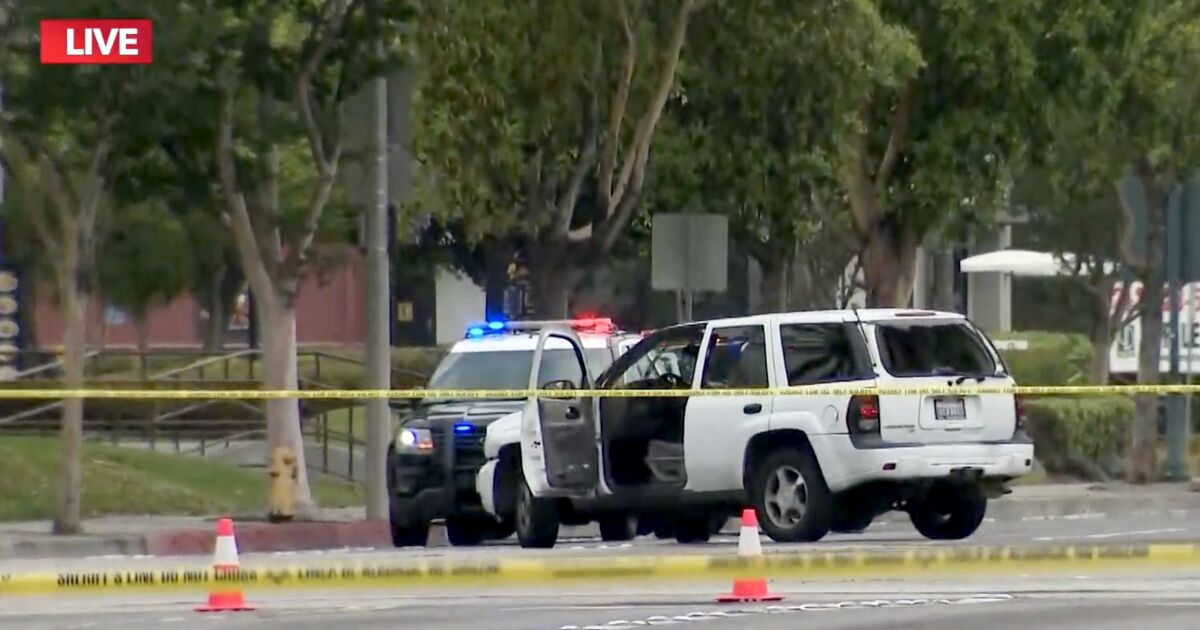 www.latimes.com
www.latimes.com
cross-posted from: https://lemmy.ml/post/1449166 > A Los Angeles County sheriff’s deputy shot a man early Thursday in Bell Gardens in an incident that left bullet holes in the man’s vehicle and signs a patrol cruiser had been rammed. > > The deputy shot the man about 4:30 a.m. during a traffic incident at Florence and Eastern avenues, according to the L.A. County Sheriff’s Department. > > The wounded man was taken to a hospital by paramedics. Sheriff’s officials did not provide any further details of the events leading up to the gunfire, whether the man was armed or what threat he posed to the deputy. > > The deputy suffered an unspecified injury and was taken to a hospital, the Sheriff’s Department said. > > News helicopter footage of the scene at daylight showed a Sheriff’s Department SUV with a clearly smashed driver-side door, indicating a collision. A white sport utility vehicle driven by the wounded man had visible bullet holes in the front windshield and the rear windows blown out. Both vehicles were a considerable distance apart, suggesting a collision prior to the shooting. > > Sheriff’s homicide detectives responded to the scene to investigate the shooting along with the inspector general’s investigators Thursday morning.
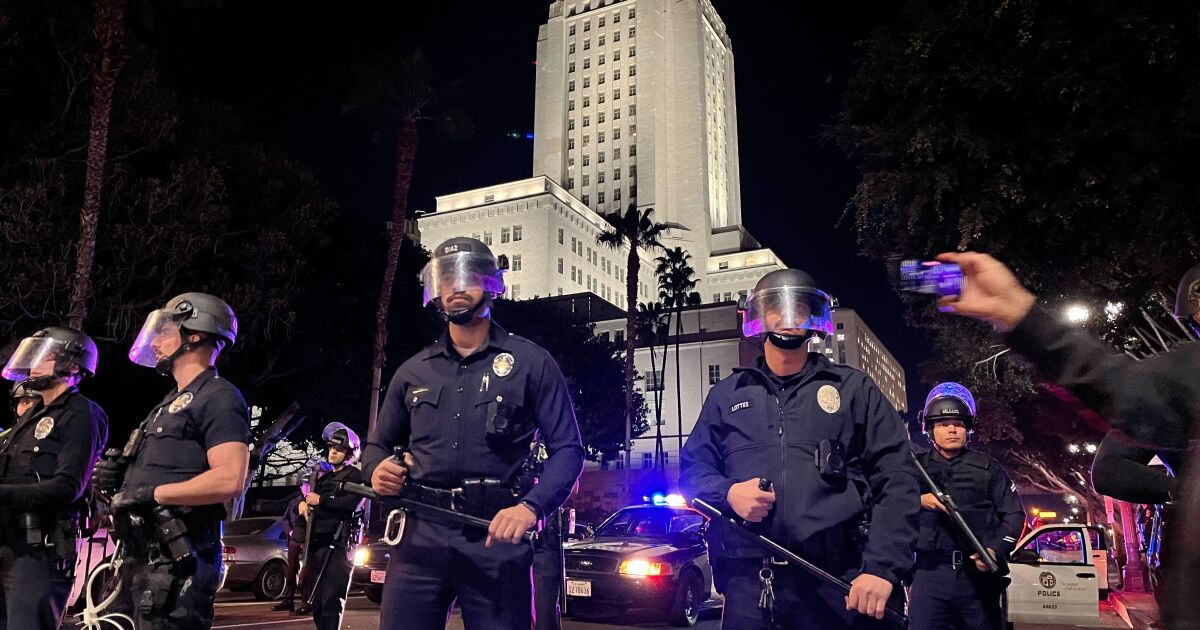 www.latimes.com
www.latimes.com
cross-posted from: https://lemmy.ml/post/1449156 > An off-duty Los Angeles police officer was arrested Wednesday in San Bernardino County on suspicion of allegedly following a fellow bar-goer into a bathroom and stabbing the man, according to sources with the Los Angeles Police Department. > > Arthur Contreras, 55, was arrested at about 3:14 p.m. Wednesday by Upland police at a home in the city of nearly 70,000 on the western edge of San Bernardino County. He was booked into the West Valley Detention Center in Rancho Cucamonga on suspicion of assault with a deadly weapon. > > He was released from jail after posting $40,000 bail, and has an initial appearance at at Rancho Superior Courthouse in Rancho Cucamonga set for Friday morning. > > It was unclear whether he had an attorney. > > An LAPD personnel roster shows that Contreras is an officer with the Detective Support and Vice Division and joined the force in 1995. > > Specifics about the incident weren’t immediately known, but a department source with knowledge of the case said the alleged attack occurred around lunchtime Wednesday at an unnamed bar. Contreras is suspected of following a fellow bar patron into a bathroom, where the off-duty officer allegedly tried to stab the man in the chest but instead cut the man’s arm, according to the source. > > Subscribe to Continue Reading > > Capt. Kelly Muniz, a police spokesperson, Thursday confirmed Contreras was an LAPD officer. She said Contreras has been put on administrative leave but referred further questions to the Upland Police Department. > > The San Bernardino County District Attorney’s office didn’t immediately respond to a request for comment Thursday morning.
 www.latimes.com
www.latimes.com
cross-posted from: https://lemmy.ml/post/1448888 > If P-22, the late mountain lion, was the unofficial mascot of L.A., then Pinky the papier-mâché bird was the decidedly less majestic mascot of Eagle Rock, the small, hilly neighborhood tucked on the city’s northeast boundary. > > No one’s quite sure how Pinky popped up. Around 2014, the bird appeared in a nest atop “Pillarhenge,” a famous (or infamous) series of columns built as the foundation of a would-be Great Recession-era housing development on Colorado Boulevard. > > The development was never finished. Abandoned since the 2008 housing crisis, the property has served at times as a homeless encampment, dumping ground and playground for graffiti artists. > > The pillars became a white elephant of the recession, an eyesore that locals have come to love, hate or begrudgingly accept. While Stonehenge evokes mysticism and Wiccans, Pillarhenge evokes confusion and dysfunction, serving as a concrete reminder of L.A.’s inability to deal with its housing woes. > > The bird had a deeper fan base, becoming an Eagle Rock celebrity with a line of T-shirts and tapestries. For the last eight years, Pinky watched over a city that couldn’t quite figure out how to house itself. > > Then in April, Pinky was gone, stripped from its pillar-top nest. A sign perhaps? Was Pillarhenge coming down too? > > Residents wondered what would rise in its place on 1332 Colorado Blvd., a long, narrow property that has never been developed. > A papier-mâché bird atop a concrete pillar > > Pinky, a papier-mâché bird that turned into a local mascot, sat atop Eagle Rock’s “Pillarhenge” for years before it was removed this year. > > (Merry Larsen) > > Before the pillars, the property was known among locals as the place where an LAPD officer shot 18-year-old Mark Moser to death in 1978 after Moser’s pickup truck collided with an undercover police car at the end of a stakeout and subsequent car chase. > > Resident Kevin Grace, Moser’s classmate at Eagle Rock High School, said the property has carried a bizarre mystique since the killing. > > In March 2015, Grace co-founded “Friends of Pillarhenge Park,” a Facebook group tracking the property’s development and advocating for its potential use as a park. To date, the group has 824 members. > > Developers have attempted to build something on the property over the last two decades, but never a park. Jay Vanos of Vanos Architects has been involved with the site since 2003, when he worked with a developer envisioning a 17-unit live-work space there. > > It didn’t come to fruition and sold to another developer, who erected the now-famous pillars before going bankrupt. The lender took control for a few years before the property was sold to Imad Boukai for $1.9 million in 2016. > > Boukai, chairman of Anaheim-based company General Procurement Inc., envisioned a four-story mixed-use development with 31 apartments above two levels of parking and commercial space. > > He tapped Vanos, who planned a structure that would take up the vast majority of the relatively small lot, which covers just over half an acre. The plans became public in 2017, and due to its ship-like look, residents started calling it the Love Boat, a nod to the 1970s sitcom set on a cruise. > > “Let their imaginations take them where they will,” Vanos said. > A rendering of the proposed project, which locals have dubbed "the Love Boat." > > (Jay Vanos Architects, Inc. / MGIDesign) > > As with most small towns subsumed by a big city, Eagle Rock residents felt protective of the community and wary of potential developers. They voiced strong opinions. Months of discourse and meetings with council members ensued, with some locals jeering at the nautical design and others expressing relief that the site would finally be developed. > > “I’d rather suck it up and see it developed into a functional property,” said Grace, who was born in Eagle Rock. “Right now, it looks like something from a forgotten town. That’s worst-case scenario.” > > The Eagle Rock Assn., a volunteer group founded in the 1980s aiming to guide the community’s growth in a sustainable way, published a letter in 2017 pointing out the significance of the site’s location. The property parallels a freeway offramp leading into Eagle Rock, so the Love Boat would be the first thing people see when entering the neighborhood. > > The letter said the board was split on the design, but members support the development because the property had been “blighted and abandoned for so many years.” > > Progress stalled again, and Boukai sold the unfinished property in 2022. He declined a request for comment. A source familiar with the deal suggested that building costs became too expensive since the lot is on a steep hill that requires significant grading and maintenance. > > Next up was Ara Tchaghlassian, founder of American Tire Depot, a Vernon-based retailer with more than 100 locations. Tchaghlassian sold the tire company in 2021 and bought the Pillarhenge lot from Boukai months later for $2.765 million, real estate records show. > > It appears the Love Boat will set sail after all, as Tchaghlassian is picking up where Boukai left off. He declined a request for comment, but a construction permit posted at the site shows the same plans mapped out by Boukai: a four-story development with 31 apartments, including three extremely low-income units, above two levels of parking and commercial space. > > Grading began late last year, and Pinky was removed in the spring. The source said the complex will probably be completed in roughly two years. > A construction worker works on a project at a property in Eagle Rock > > A construction worker at the Eagle Rock site that is being developed into a multifamily, mixed-use complex. > > (Jason Armond / Los Angeles Times) > > “I’m sick of looking at it,” said Diane Lopez, who walks past Pillarhenge on her daily stroll. “Just build something. Anything.” > > The pillars will remain, though they won’t be visible once the structure is completed, Vanos said. > > As for why a developer would take on the headache of Pillarhenge, the answer is simple: the Transit-Oriented Communities Incentive Program. > > L.A. has a housing shortage, and it needs a multifaceted approach to address it. As part of its housing element plan, the city is required to zone for a quarter-million homes by 2024. > > To reach that goal, the city has introduced various incentives to encourage multifamily development as part of its Housing Element Rezoning Program, and the Transit-Oriented Communities incentive has been one its most successful tools. > > The program encourages the development of affordable housing near bus and train stations by offering developers more density and less parking requirements for their projects if they build near transit centers. > > According to the city’s planning department, over the last six years, 36% of new multifamily developments have taken advantage of the incentives, and the Pillarhenge project is one of them. It qualifies for the second tier of incentives, meaning it gets a 60% increase in the maximum number of units, an increase in floor-area ratio and a reduction in the number of required parking spaces. > > “We need responsible, robust development that’s affordable and successful for Angelenos. Right now, we don’t have enough,” said Greg Good, a senior advisor on policy and external affairs for the Los Angeles Housing Department. “The Housing Department and the rest of the city are working relentlessly to facilitate and expedite that process, and we do that by creating programs that work.” > > There are myriad reasons why developers abandon a project: running out of money, permitting problems, pandemics. During a housing crisis, it’s the city’s job to make multifamily housing a viable option for developers. > > For Pillarhenge’s latest developer, the incentives may be enough to bring housing to the long-abandoned lot. For now, residents wait to see whether a Love Boat will be better than a Pillarhenge.
 www.latimes.com
www.latimes.com
cross-posted from: https://lemmy.ml/post/1448812 > Prompted by the release of information about thousands of Los Angeles police officers that activists posted to a public online database, City Atty. Hydee Feldstein Soto is trying to convince California lawmakers to weaken the state’s public records law. > > While Feldstein Soto describes her proposal as a minor tweak to the California Public Records Act, civil rights advocates say it would severely diminish the power of the bedrock state law that allows access to information held by local governments and state agencies. > > “That proposal would completely gut the Public Records Act,” Melanie Ochoa, an attorney who is the director of police practices for the American Civil Liberties Union of Southern California, said after reviewing a copy obtained by The Times. > > “There would be really no transparency element of the PRA anymore if that were to become law.” > > The city attorney’s effort amounts to the latest volley in an ongoing tussle between city officials and community activists who have used the public records law to obtain information they see as helpful in holding police accountable for misconduct. > > California’s public records law already exempts from disclosure the home addresses and phone numbers of public employees as well as other information that could “constitute an unwarranted invasion of personal privacy.” So the change the city attorney is seeking could block the public from identifying government workers in their professional capacities. > > While she framed her proposal as a necessity to protect a range of public-sector workers who could be subject to harassment — including sanitation employees who dismantle homeless encampments and public health workers who promote vaccinations — Feldstein Soto acknowledged that it was inspired by the public records request that led to the release this year of pictures and data of more than 9,300 L.A. police officers. > > “I’m trying to address the wholesale doxxing of people that we need to depend on to do the business of government, without any reason other than the position that they happen to hold,” Feldstein Soto said. > > “Having a tool in the toolbox of activists that is not aimed necessarily at the policy of the government, but aimed at intimidating the individuals who are carrying out the policy seems to me to be something where we could all come together to try to protect working people.” > > Feldstein Soto traveled to Sacramento last month and said she met with two dozen lawmakers about her proposal. So far none have agreed to put it into a bill, but Feldstein Soto remains hopeful. Even though several lawmakers were skeptical of the idea, she said many more were “affirmatively enthusiastic and supportive.” > > Lawmakers in Sacramento are halfway through the 2023 legislative session, which makes passing a newly introduced bill a big political lift. Legislation introduced at this point would go through an abbreviated review process, giving lawmakers less time to scrutinize the proposal and allowing limited public input. > > Assembly Speaker Anthony Rendon (D-Lakewood) met with Feldstein Soto about her desire to change the public records law and “is sympathetic to the issue,” said Rendon spokesman John Casey. Rendon asked his staff to look for a way to get her proposal into a bill, Casey said, but so far that has not happened in the Assembly. In the state Senate, a spokesperson for Senate leader Toni Atkins (D-San Diego) said her staff met with Feldstein Soto about the proposal but that Atkins is not considering putting it in legislation. > > In addition to allowing local governments to withhold photos and identifying information about their employees from the public, the bill Feldstein Soto drafted also would allow local governments to block the release of information that identifies people experiencing homelessness or receiving government benefits, as well as information on services provided to them. She said she’s aiming to shield people who are moved into housing or shelter from being sought out by pimps and drug dealers. > > It would be “a discretionary exemption for purposes of basically preserving the safety of the folks,” she said. “We [could] redact the information that would allow somebody to target them.” > > But it’s requests for information about L.A. police officers that have sparked the biggest dust-up over the power of the Public Records Act. > > In March, a group called the Stop LAPD Spying Coalition launched a searchable online database with the names, photos, ethnicity, rank, date of hire, division/bureau and badge numbers of more than 9,300 officers, including a few hundred who work undercover or in other sensitive positions. The group encourages community members “to observe and document police abuses, especially arrests and other violence,” according to its website, and publishes a guide for activists on how to use public records laws to advance the goal of abolishing police. > > Leaders of the Stop LAPD Spying Coalition previously told The Times that the information they published was obtained from the Los Angeles Police Department through a public records request. City officials say the undercover officers were inadvertently included in the response and are investigating how it happened. > > In an attempt to claw back the photos of the undercover officers, the city sued the Knock LA journalist who filed the public records request and the Stop LAPD Spying Coalition. Last month, a Los Angeles judge rejected the city’s controversial request that he order the journalist to return a flash drive of police officers’ photographs. > > Tom Saggau, a spokesman for the Los Angeles Police Protective League, said since the database went up several officers have faced threats and have reported them to the department, but he declined to provide details. > > When Feldstein Soto approached the officers union about her idea to narrow the Public Records Act, Saggau said, “we conveyed to the city attorney that if a bill was introduced that prevented these types of doxxing disclosures that there was a high likelihood we would support it.” > > The president of the union that represents Los Angeles social workers said that although it does not yet have a formal position on Feldstein Soto’s proposal, it sounds appealing as a potential tool to protect employees. Social workers who intervene when families are in crisis have faced threats of death and harm to their families, and had confidential information about themselves posted on social media, said David Green, president of SEIU Local 721. > > “It’s an accident waiting to happen,” he said. “I’m a firm believer in transparency and accountability, but at the same time, I’ve had to represent workers ... [whose] health and safety and their life, sometimes, is really threatened by the people we serve, unfortunately.” > > But civil rights attorneys refuted the notion that the public records law puts government employees in harm’s way. It does not allow disclosure of personal information, such as home addresses or family information, said Ochoa, the ACLU attorney — only work-related information. > > “The courts have recognized that knowledge of who is working in the public and for the public is something the public has a right to know,” she said. > > Ochoa pointed to the public records law as a critical tool in efforts to improve police practices and hold law enforcement agencies accountable because it can be used to identify specific officers. Without that power, she said, it would have been impossible to advocate for other transparency laws California passed in recent years to require more disclosure of internal records on police shootings and to create a system for decertifying officers for serious misconduct. > > “That would not have been possible if we weren’t made aware that the same officer that killed someone had gone to another agency and killed someone else,” Ochoa said. > > “We would oppose any attempt to gut the PRA in this way.”
 www.latimes.com
www.latimes.com
cross-posted from: https://lemmy.ml/post/1443027 > Alex Khachoyan, 64, is layering chunks of orange-tinged chicken breast onto metal skewers in the backyard of his Pasadena home. He deftly works the meat onto each spear without looking, a muscle memory he’s developed over decades of cooking for family, friends and customers. > > “I’m eating barbecue almost every day,” he continues. > > Grilling with his family is a weekly ritual for Khachoyan, who runs Garni Meat Market on a stretch of Washington Boulevard in Pasadena known as Little Armenia. Following advice from his doctor, he left his job as an auto body painter to open the butcher shop nearly 30 years ago. Now, he works alongside his son Harout, 28. > > The shop is named for the village in Armenia and the Garni temple, believed to have been built around AD 77. It’s also an homage to the memory of a late friend who lived there. > > “And my mom said Garni is a nice name,” he says. > > It’s just after noon on a recent Monday, and Alex and Harout are working together to prepare a meal for family and friends. > Close-up detail of marinated meats and flatbread on the grill. > > Alex Khachoyan runs Garni Meat Market, located on a stretch of Washington Boulevard in Pasadena known as Little Armenia. The shop is named for the village in Armenia and the Garni temple. > > (Liana Grigoryan / For The Times) > > He uses a match to set the coals ablaze in a grill outfitted with a shallow, wide bed and slits along the edges designed to hold skewers. They call it an “Armenian” grill, and for $185 at the shop, you can have one too. > > “You call somebody and say we’re doing khorovats, which means we’re grilling,” says Harout. “It’s an Armenian thing. That’s a sign to come over. It’s a family event and it’s really important to my culture.” > > On a table nearby, Alex continues to skewer the day’s lunch, a selection of proteins prepared at the shop: filet mignon in a dry marinade of black pepper, paprika, Aleppo pepper and onions; pork chops and squares of pork belly heavily seasoned with salt, black pepper and Aleppo pepper; lemon pepper chicken wings; ground lamb studded with sweet onion; and chicken breast marinated in yogurt and mayonnaise, fresh garlic, paprika and salt. > > Alex and Harout make 14 marinades for the shop, displayed in a glass case that runs the length of the store. In addition to the marinated meats, there are Tomahawk steaks, the dry, spicy sausage sujuk Alex makes himself and a selection of dips and spreads including hummus, Alex’s own yogurt, ajika and jajuk. > A young man and his father stand behind the counter at their market. > > Alex Khachoyan, right, with son Harout Khachoyan at Garni Meat Market, where Alex makes the spicy dry sausage sujuk and yogurt. > > (Liana Grigoryan / For The Times) > > They’ve brought a little bit of everything home with them for lunch. Alex’s wife, Tina, 63, is in the kitchen making rice pilaf, and Harout’s wife, Karen, 27, is nearby scooping the various dips into bowls alongside Tina’s homemade pickles and salads. > > Harout tends to the fire, using a hair dryer attached to a long extension cord to hurry the coals toward white-hot. He sticks a bare hand into the grill to move a piece from the outer rim to the middle. > > Next, Alex skewers green peppers, eggplant and tomato. The vegetables are the first on the grill. > > “Without these vegetables, we don’t eat the barbecue,” he says. “We roast them, pull the skin off, chop it up, then add cilantro, parsley, garlic, onion, olive oil and salt to make a salad.” > Mixing spices and onion with meat inside of Garni Meat Market store. > > The Khachoyans make 14 marinades for their shop, displayed in a glass case that runs the length of the store. > > (Liana Grigoryan / For The Times) > > As soon as the vegetables are removed, the grill is filled with meat. The skewers are packed in close but never touching. Harout draws from a stack of dried grape vines underneath the grill and adds them to the fire. Throughout the year, they cut the vines growing off the side of the house and save them to use while grilling. During walnut season, they throw in the walnut shells. > > “It’s more tasty,” Alex says. “It adds more flavor.” > > It also enlivens the smoke, now sweeping and falling from the grill in thick gray clouds. Even from across the backyard, you can taste the smoke on the wind. > > “I making this,” Alex says, proudly pointing to a long cylinder that holds dozens of metal skewers. It looks like a quiver, made from a sewer pipe he closed off at one end and a handle fashioned from a damaged piece of car molding. > > “I making the car. I making the home. I making everything,” he says, his woolly mustache twitching as he laughs. > > He also made the metal skewers, using a vise to twist the metal to create handles at the ends. He calls them Armenian swords. > > When it’s time for the ground lamb, Harout keeps a close eye on the meat, hand-pressed into cigar-like patties along the skewers. > > “You have to keep rotating them so they don’t fall off and cook on both sides,” he says. > > While about half of Garni’s customers have their proteins grilled at the store, many buy the marinated meat and rely on the Khachoyans for grilling tips to cook at home. The family is adamant about the use of a charcoal grill, but they’ll offer instructions for alternative forms of grilling, baking or pan-frying. > Alex Khachoyan and his wife, Tina, prepare a feast in their backyard. > > Alex Khachoyan and his wife, Tina, prepare a feast: “You call somebody and say we’re doing khorovats, which means we’re grilling,” Alex says. “It’s an Armenian thing. That’s a sign to come over.” > > (Liana Grigoryan / For The Times) > > A little more than a year ago, the family started offering plates of grilled meat, rice and vegetables that you can eat on the patio out front. > > As the meat nears ready, Harout rips open a package of mottled lavash and slides out a flat piece of bread about 3 feet long. He tears off a piece and uses it as a makeshift glove to remove a piece of pork belly from a skewer. He nonchalantly pops the steaming piece of meat into his mouth, oblivious to the heat. > > He then offers a piece to a friend he’s invited over for lunch, who seems to appear out of thin air as soon as the meat is ready. > > “Usually we’re really full before we even get to the table,” Harout says, still chewing. “We will be picking at the meat while we grill.” > > He layers some serving dishes with bread, then continues to remove the meat from the skewers, piling the pork, chicken, lamb and beef over the lavash. The family takes turns bringing the meat to a table on the side of the house, already full of pickles, salads, spreads and wine glasses. There’s also an ice-cold bottle of vodka and empty shot glasses waiting. > > The platters are passed around the table, with everyone choosing their favorite cuts. Harout prompts his father to take the “good piece” of pork chop, the one with a nice rim of fat caramelized around the bone. > > Alex makes himself a bite of food with a piece of torn bread, pork and a scoop of his grilled vegetable salad. > Alex Khachoyan and son Harout work the grill at Alex's home. > > “Usually we’re really full before we even get to the table,” Harout Khachoyoan, left, says. “We will be picking at the meat while we grill.” > > (Liana Grigoryan / For The Times) > > “Armenian people don’t eat barbecue with a fork and knife,” he says. “They eat with hands. You taste it more.” > > The filet mignon is impossibly tender, almost melting into the lavash beneath. The chicken is vibrant with Aleppo pepper, springy but still moist. The pork chop bones are excavated for every last morsel of meat. The luleh kebab, full of onion and paprika-infused juices running wild, is the first to disappear. > > Wine is sipped. Vodka is shot back. The platters of food slowly diminish as the conversation becomes more lively, everyone more animated and a little glassy-eyed. > > It’s a scene that plays out in countless Garni customers’ homes and backyards, fueled by the Khachoyans’ marinated kebabs. > > “Having the shop makes us feel like you’re providing a service, but it’s something more than that to the families coming in,” Harout says. “We’re part of a very tight-knit Armenian community, and sometimes, our store gets to be at the center of it. ” > Alex Khachoyan is showing his plate of grilled meats. > > Alex Khachoyan shows the results of his grilling skills. > > (Liana Grigoryan / For The Times) > > Where to buy meat for grilling > > Garni Meat Market, 1715 E. Washington Blvd., Pasadena, (626) 798-2676
 www.latimes.com
www.latimes.com
cross-posted from: https://lemmy.ml/post/1442833 > If the sun comes out and the afternoon is free, the air and light of Los Angeles urges us to go outside and grill food over fire. In my home, that would take shape as a classic carne asada. So when it finally got sunny this week — mercifully — I immediately decided to light up the grill. > > I live in a mixed Black, Mexican, Salvadoran neighborhood, and in order for such a place to exist it must contain a family-owned corner market or carnicería. My community has two. If the feeling hits, I’ll first stop at Tito’s Meat Market on East Hyde Park Boulevard, for ears of corn, nopales, chiles, limones and fresh avocados for guacamole. Then I’ll hop across the street to Carnicería La Tapatía for the centerpieces: north-of-the-border style marinated beef, some marinated chicken and maybe chorizo. In short order, an L.A. carne asada is born. > > Grilling is a feature of almost every culinary culture, and it’s all reflected in L.A.’s interlocking communities. Filipino skewers. Japanese yakitori. Middle Eastern kebab. Argentine and Chilean asados. Thai satays. And of course, Korean barbecue. All contribute to the great cacophony of how we cook with fire in Los Angeles. > > Restaurateur and cookbook author Bricia Lopez offers us a delicious sample of her carne asada traditions, as seen on a recent bright afternoon at Ernest E. Debs Regional Park with L.A. Times Food general manager Laurie Ochoa and plenty of friends. The recipes in Lopez’s new book with Javier Cabral, “Asada: The Art of Mexican-Style Grilling,” should join any of your own carne asada traditions, especially her arrachera verde marinade, which hits that perfect chord between tradition and innovation. > > As Bill Addison and Danielle Dorsey note in a fresh guide, American-style barbecue is the province of Black Angelenos who carry the traditions of their ancestors from the U.S. South. Because L.A. is so L.A., barbecue is also increasingly being interpreted and redefined. News-flash: We have a lot of great barbecue in SoCal and don’t let anyone tell you anything different. > > In Pasadena, Jenn Harris introduces us to the owner of Garni Meat Market and L.A. Armenian grilling. “Without meat, I don’t have a life,” 64-year-old market owner Alex Khachoyan tells Harris, and, tío, I feel you 100%. > > I am aware that one day soon, though, meat might no longer be a viable option for cooking with fire. Vegans and vegetarians are already there. Cooking columnist Ben Mims celebrates the veggie burger and tells us that we don’t have to lose the luster of a grilling moment if we skip the meat. > > In a photo essay publishing Friday, Times photographers Jason Armond and Al Schaben and freelancer Shelby Moore team up with Dorsey and explore the state of grilling at L.A. parks right now. As you read it, I suggest calling up a song that to me typifies grilling in SoCal’s beloved public parks, “On a Sunday Afternoon” by Lighter Shade of Brown, and sing along to the phrase, “just waiting for the sun to go down.”
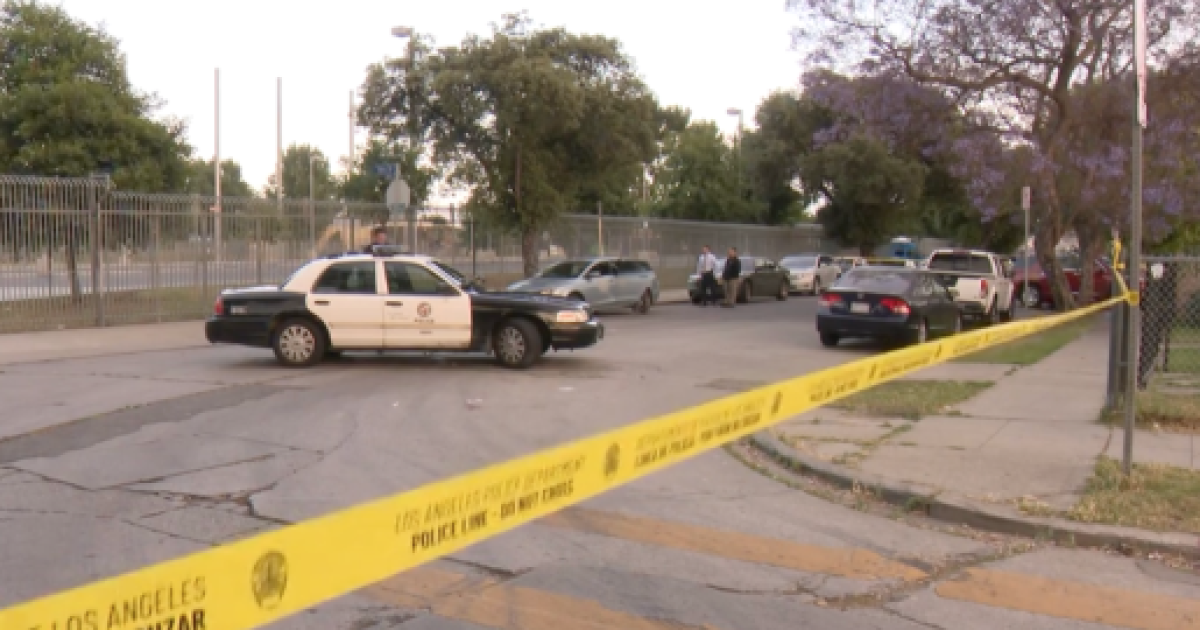 www.latimes.com
www.latimes.com
cross-posted from: https://lemmy.ml/post/1436828 > Three teenage boys were arrested Wednesday on suspicion of shooting a 1-year-old child and her mother, according to Los Angeles police. > > The shooting, which police said was likely gang-related, occurred around 5:30 p.m. June 5 near 81st Street and Avalon Boulevard in South Los Angeles. > > The victim and another woman, both in their 20s, had parked at a hamburger stand on the corner with their young children, ages 1 year and 8 months, sitting in the back seat. > > A gray Kia sedan pulled up alongside the victim’s car and fired several shots inside before driving away. The shooting left the 20-year-old mother with a wounded leg and her 1-year-old daughter with a foot wound, according to police. Both injuries were nonfatal, and the other two occupants were not injured. > > A police investigation determined the shooting was likely gang-related and that the victims were mistakenly targeted as rival gang members. A search warrant yielded surveillance footage that led authorities to identify the suspects, a 17-year-old boy and two 16-year-old boys. Their identities were withheld because they are minors. > > All three suspects were arrested Wednesday on suspicion of attempted murder. Charges have been submitted to the Los Angeles County district attorney’s office for consideration. > > The police investigation is ongoing. Anyone who may have information can contact the 77th Street Area Gang Impact Team at (323) 786-5414. Tips can also be provided anonymously by calling L.A. Regional Crime Stoppers at (800) 222-8477.
 www.latimes.com
www.latimes.com
Police have arrested two people in connection with the robbery of a South Los Angeles McDonald’s after a video of the incident went viral on social media. The incident occurred at around 7:45 p.m. Monday in the 4300 block of Crenshaw Boulevard, authorities said. Footage of the robbery, which made the rounds on TikTok and Reddit earlier this week, shows a group of approximately five people vandalizing the inside of a restaurant, throwing chairs, food and other items at workers, some of whom can be seen running behind the counter for safety. People can also be seen taking and smashing cash registers as workers move into the kitchen. Officers in the area saw a large group of people exit the restaurant and detained one person. He was booked on suspicion of receiving stolen property, but could not be specifically connected to the robbery at the time, Los Angeles Police Department officials said in a release. “Due to the violent nature of the large group, the arrestee was removed from the location along with law enforcement,” officials said in a statement. Detectives reviewed video of the incident posted to social media, as well as security camera footage. The footage allegedly showed the man who had been detained at the scene had jumped over the counter and taken a cash register. The man, whom authorities identified as Kenneth Fowler, 19, of Lomita was arrested Monday on suspicion of robbery and booked into Los Angeles County jail. A male juvenile was also identified as a suspect and arrested on suspicion of robbery. He was booked and released to a guardian or parent, police officials said. Authorities did not release his name, as he is underage.
 www.latimes.com
www.latimes.com
cross-posted from: https://lemmy.ml/post/1430860 > The Clippers are deep in negotiations to make their first roster alterations ahead of the next NBA season. > > By Wednesday afternoon, the team remained in discussions toward a three-team trade that, if completed, would send the expiring contract of forward Marcus Morris Sr., the former starter who had lost his rotation spot late last season, promising but little-used forward Amir Coffey and the 30th pick in Thursday’s NBA draft to Washington, and take back guard Malcolm Brogdon from Boston, according to a person briefed on the trade talks but not authorized to speak publicly on the matter. > > Brogdon, 30, is a former rookie of the year who last season played 26 minutes off the bench for the Celtics while averaging 14.9 points, 4.6 assists and 4.2 rebounds. At 6 feet 5, he would add size to the Clippers’ backcourt, while also adding risk of injury to a team already with plenty. Brogdon missed 15 games this season and 46 in 2021-22. > > Boston would fortify its frontcourt in the exchange by adding Kristaps Porzingis, who would need to opt into his next season’s salary before being traded. > > The deal could not become official until after Thursday’s draft because of a league rule that prevents teams from being without a first-round pick in consecutive years. The Clippers, in this scenario, would select the 30th pick on behalf of Washington, then send the new draft pick to the Wizards. > > Subscribe to Continue Reading > > Get our high school sports newsletter > > Prep Rally is devoted to the SoCal high school sports experience, bringing you scores, stories and a behind-the-scenes look at what makes prep sports so popular.
 www.latimes.com
www.latimes.com
cross-posted from: https://lemmy.ml/post/1426998 > Los Angeles City Councilmember Curren Price called on his colleagues Wednesday to reject a proposal to suspend him from the council, saying he is innocent and deserves the chance to respond to “misguided charges” filed by the district attorney’s office. > > Price said that until he has an opportunity to respond, it would be “inappropriate” for the council’s Rules, Elections, and Intergovernmental Relations Committee to recommend his suspension — a move that would strip him of all his duties, including his ability to cast votes. > > “While I respect that Council President Krekorian has to take any allegations against a member of the council seriously, I am presumed innocent, as indeed I am,” Price said in a statement. “And the best way to protect the voices and concerns of those in my district is to allow me and my dedicated staff to continue to serve the needs of District 9.” > > Price’s statement comes more than a week after the district attorney’s office filed a case charging Price with 10 felony counts. > > In addition, prosecutors have charged Price with embezzlement of public funds, saying he had his now-wife receive city health benefits at a time when their marriage was not legally valid. > > The City Charter gives the council the power to suspend any city elected official who has been charged with a felony, regardless of whether he or she has declared their innocence. > > The rules committee is scheduled to meet Friday to take up its suspension proposal, which would ultimately require full council approval. However, it’s not clear whether that three-member panel will decide the issue with only one meeting. > > Suspension would have huge consequences both for Price and his South L.A. district, which takes in some of the city’s most impoverished neighborhoods. If Price were suspended, Krekorian and his colleagues would need to decide whether to select a non-voting caretaker or a temporary voting council member to oversee the district. That arrangement could last quite a while, since Price started his third term in January and has three and a half years left in his term. > > If the council votes to suspend, City Controller Kenneth Mejia would likely move to strip him of his pay, potentially undercutting Price’s ability to pay for defense lawyers. In December, Mejia made clear that he would stop paying the salary of any council member who is suspended, saying such an action is spelled out in the City Charter. > > “Once City Council bars a councilmember from their duties, it is the controller’s responsibility to stop paying them for not working,” Mejia wrote last year on Twitter. > > The council has suspended two colleagues since 2020: Jose Huizar and Mark Ridley-Thomas, both of whom were charged in federal corruption cases. Huizar later pleaded guilty, while Ridley-Thomas was convicted by a jury of seven counts. > > Krekorian did not immediately respond to The Times’ inquiries about Price’s statement. But in recent days, he has promised to move more slowly on the suspension process than the council did with Huizar and Ridley-Thomas. > > During an appearance Wednesday on Tavis Smiley’s talk radio show on KBLA-AM 1580, Krekorian said the public should not assume that Price will be suspended simply because a suspension motion is being considered. > > “This is simply to allow the conversation to begin,” Krekorian said. “It’s not the end of the conversation. It’s the beginning of the conversation.” > > Councilmember Marqueece Harris-Dawson, who sits on the rules committee, has begun raising questions about the severity of the charges filed against Price, saying the D.A.’s case has left him and others “scratching their heads.” Harris-Dawson said earlier this week that he wants residents of Price’s 9th District to have the ability to weigh in on any suspension proposal. > > “I am committed to working with the [council] president to have official hearings in the 9th District, should this process go any further,” Harris-Dawson said. > > Harris-Dawson declined to say earlier this week whether he thinks suspension of Price is warranted. Meanwhile, Price said he is eager to respond both to the D.A.’s “misguided charges” and to “unfair aspersions” cast against his wife, Del Richardson Price. > > “I am confident that the court, and any fair observers, will recognize that these charges are unwarranted,” Price said. > > Price had been a member of the rules committee before the charges were filed last week. Krekorian has appointed Councilmember Hugo Soto-Martinez, who represents a Hollywood-area district, to fill Price‘s seat on the committee. > > Soto-Martinez said last week that he would vote in favor of suspending Price. On Wednesday afternoon, he declined to comment on Price’s statement.

cross-posted from: https://lemmy.ml/post/1423090 > Have a Nice Day, everybody!
 www.latimes.com
www.latimes.com
cross-posted from: https://lemmy.ml/post/1419856 > He is relatively new on the job at the Los Angeles Police Department, but Bosco, a 2-year-old Dutch shepherd, has a nose for trouble. > > The narcotics detection canine sniffed out the secret held inside a soda vending machine at a downtown L.A. repair garage — it contained a large stash of heroin, fentanyl and an assault rifle, police said. > > “There was a lot more than Coke in that soda machine,” said LAPD Capt. Lillian Carranza, who oversees the Gang and Narcotics Division, which includes several K9 officers. > A split image of a soda vending machine at left and a dog posing for a photo at right. > > The soda machine in a downtown Los Angeles repair garage where the drugs and assault rifle were found by Bosco, a 2-year-old Dutch shepherd who has worked with LAPD narcotics investigators for six months. > > (Los Angeles Police Department) > > Ventura County Sheriff’s Department investigators were conducting a search warrant Friday at the undisclosed garage location in central Los Angeles and requested LAPD assistance with one of its canines, Carranza said. > > Bosco, with six months’ experience on the job, entered the garage and keyed in on the soda machine. From the outside, it looked like any other in businesses across L.A., but investigators opened up the machine and found 15 pounds of heroin, a kilogram of fentanyl and an assault-style rifle concealed inside, according to Carranza. > > “Bosco is amazing. This is his third deployment. He is finding everything,” said Carranza, who often posts images of her division’s canine standouts on social media. “When regular officers cannot find anything, he can perform miracles.” > > Subscribe to Continue Reading > > The LAPD would not provide further details about the bust because it was part of a larger ongoing investigation by Ventura County sheriff’s detectives, Carranza said.
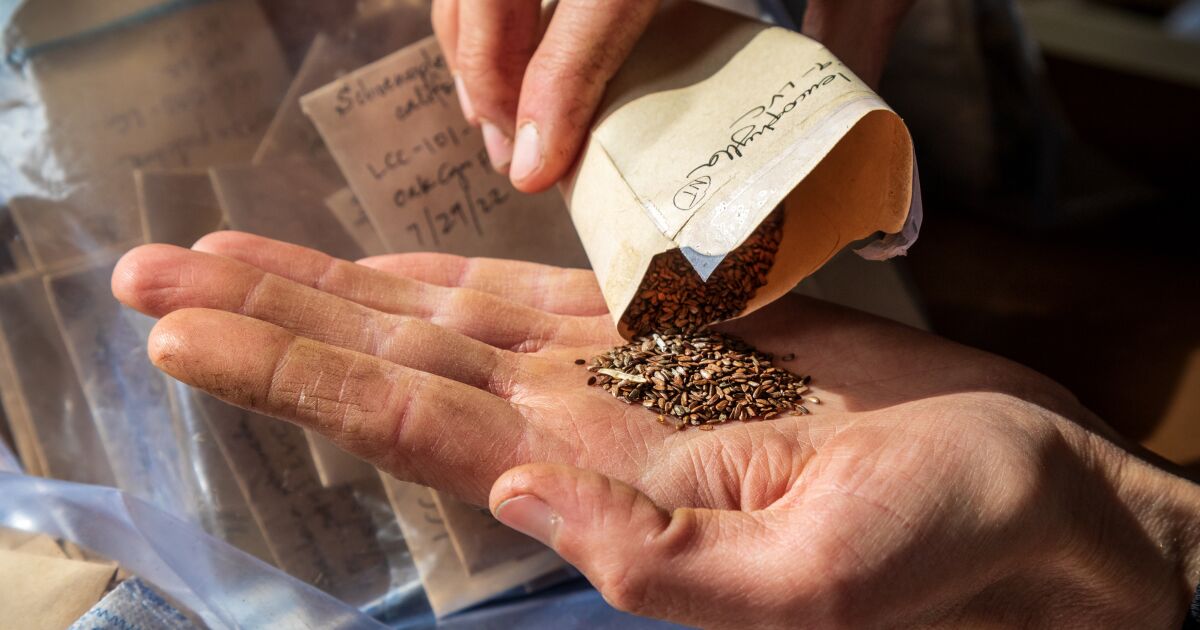 www.latimes.com
www.latimes.com
cross-posted from: https://lemmy.ml/post/1418797 > Full Artical won't fit. > > How do you create a convincing span of nature over one of the state’s busiest freeway corridors so wildlife like L.A.’s famous, ill-fated cougar, P-22, can cross unscathed? > > First you build a nursery and collect a million hyperlocal seeds. > > This is not hyperbole. After Katherine Pakradouni was hired in January 2022 to grow the plants for the upcoming Wallis Annenberg Wildlife Crossing in Agoura Hills, she spent much of the year combing the hills within five miles of the crossing, collecting — yes — more than a million seeds from native plants. > > Before she went collecting, she had to build a special nursery near the north side of the crossing, where she and her team are planting those seeds to grow trays and trays of the native flora that will fill the crossing when the concrete superstructure is completed late next year. > > Those girders are scheduled to be installed over several weeks, starting this fall, between midnight and 5 a.m. The freeway will never be closed completely, Rock said. Using precast girders means the span can be constructed first on one side of the freeway and then the other, so traffic can be diverted in the wee hours to other lanes. > > Once the drainage system is completed and the soil is brought in, planting can begin. The $92-million project — split 50/50 between public money and donations to the National Wildlife Federation and its Save LA Cougars fund, including $26 million from Wallis Annenberg and the Annenberg Foundation, its largest contributor — is scheduled for completion at the end of 2025.
cross-posted from: https://lemmy.ml/post/1418012 > Teenagers filled the sidewalk outside a South Los Angeles party last week when gunfire rang out. After the crowd scattered, friends found a Crenshaw High School basketball player dead — the latest example of violence that is disproportionately killing young Black Angelenos, a Times analysis shows. > > The fatal shooting of Quincy Reese Jr., 16, left his community searching for answers, illustrating the trauma left in the wake of such bloodshed. > > “Black children are exposed to an epidemic of violence,” said Jorja Leap, a professor of social welfare at the UCLA Luskin School of Public Affairs. > > In fact, Black children and adolescents in Los Angeles County are killed by firearms at a rate three times higher than their proportion of the population, according to data from the Department of Public Health’s Office of Violence Prevention. > > The effects of that violence can be devastating not only for victims but also for survivors such as those gathered outside the party where Quincy was killed. Such trauma, and the fallout from mourning the loss of a friend or loved one, stays with children for the rest of their lives, Leap said. > > Teenagers in Los Angeles are far more likely to have been exposed to violence than those elsewhere in the U.S., according to data from the Centers for Disease Control and Prevention. More than 31% of L.A. high schoolers polled anonymously in the CDC’s 2021 Youth Risk Behavior Survey, whose results were released this year, said they had seen someone be physically attacked, beaten, stabbed or shot in their neighborhood. Nationwide, that rate was just shy of 20%. > > That violence falls disproportionately on young Black Angelenos. > > From 2016 to 2022, about 30% of teen homicide victims in L.A. County were Black, according to data from the Office of Violence Prevention, but only about 8% of the county’s teenage population is Black. > > Though California and Los Angeles County have half the youth firearm death rate of the United States as a whole, groups including Black teenage boys are killed at disproportionate rates. > > According to numbers provided by the Department of Public Health, which studied youth firearm deaths between 2016 and 2022 (2020 and 2022 data are still provisional), the countywide rate was 1.9 firearm deaths per 100,000 youths. Among boys, the rate was 3.3 firearm deaths per 100,000, among teenagers it was 5.4, and among Black youths it was 6.4. > > Before Quincy’s death, 11 minors had been killed in 2023. Four of those deaths were infants, and seven were teenagers — all boys, according to the police incident reports. One of the homicide victims was Black. > > Geographically, minors in communities clustered around downtown and South L.A. are disproportionately affected by violent felony crime per capita. > > These communities are historically and systemically underresourced, a point that Office of Violence Prevention Director Andrea Welsing cited as having an effect on rates of violence. > > “At the same time we look at prevention, intervention and healing strategies, it is important that we look at issues of racism, who has access to resources, what communities are better funded; these things matter and those things can also perpetuate violence,” Welsing said, pointing to issues such as access to quality education and housing. > > According to UCLA’s Leap, such communities are not only underresourced but are also “given the wrong resources.” > > “We’ve got to be funding classrooms in these impacted areas, in these underresourced areas,” Leap said. “We’ve got to fund the classrooms at the rate we fund the police.” > > In addition to educational resources, communities such as those around downtown and South L.A. are also less likely to have mental health resources that can help young people cope after suffering or witnessing violence. Results from the National Health Interview Survey, published this week by the CDC, show that urban children ages 5 to 17 are less likely to have received any mental health care, including therapy and medication, compared with their rural and suburban peers. > > After Quincy was killed, the outpouring of grief from his family, friends and teammates at Crenshaw High followed a familiar pattern — “the immediate aftermath of sadness, mourning, crying, memorials,” Leap said. > > But “the real problem is not in the immediate days afterwards, when invariably there is a swarm of attention,” Leap said. “The real problem is … six months later, when all the noise has died down and seemingly everything’s gone back to normal.” > > For those teenagers affected by Quincy’s death, “normal” might never be the same. > > “These kids will change forever,” Leap said. “And many of these kids in adulthood will refer back to the experience of losing a friend, a close friend, or a family member, and talk about how from that moment on in their life, they never felt the same again.” > > Times staff writer Melissa Healy contributed to this report.
 www.latimes.com
www.latimes.com
California’s two biggest reservoirs are all but full after reaching perilously low levels late last year. Lake Shasta, at 96% full, and Lake Oroville, at 100%, had fallen to around 25% to 30% of their capacity before the state’s historically wet winter rejuvenated them. Statewide, reservoirs are at 85% of total capacity, well above their 30-year average of 73% for the month of June. With the Sierra Nevada snowpack still above three times its normal level for mid-June, they are expected to fill up even more as the snow melts. The before-and-after images below from NASA show Lake Shasta on Nov. 18, 2022, when the lake stood at just 31% of capacity, and again on May 29, 2023, when it was 98% full. California’s biggest reservoir had not been so full in more than four years, according to California Department of Water Resources data. A “bathtub ring” around the lake showing how far the water lline had fallen was clearly visible in November, but it had vanished by May. Lake Oroville, in Butte County, has also undergone a spectacular transformation. The image below shows the lake near Enterprise Bridge on Dec. 21, when levels were at 29% of capacity. A narrow band of water winds through the bottom of the gully, far below the bridge’s span. Aerial view of a bridge crossing a mostly dry lake with a narrow band of water in the gully far below the bridge Lake Oroville under Enterprise Bridge had nearly disappeared on Dec. 21, 2022. (Ken James / California Department of Water Resources) Less than six months later, the landscape had undergone a noticeable shift. In the image below, taken June 12, water levels are dramatically higher at the same part of Lake Oroville, filling up nearly to the top of the piles supporting the bridge. Aerial view of a full lake with a bridge crossing A similar view of Lake Oroville on June 12, 2023, showed a dramatic transformation. The reservoir is now 100% full. (Ken James / California Department of Water Resources) In the second photo, the reservoir is 100% capacity, submerging the barren hillsides that were previously exposed by low water levels. A study of satellite data from NASA’s Jet Propulsion Laboratory found that the winter brought the greatest net gain of water in California’s lakes in the 22 years that the metric had been tracked. Between October 2022 and March 2023, the Central Valley’s “lakes, rivers, soil, snowpack, and underground aquifers” saw their levels increased by the equivalent of 20 inches, or around twice the average gain in the last 22 years. However, groundwater levels remain depleted, experts say, and may remain so into the future. “One good winter of rain and snow won’t make up for years of extreme drought and extensive groundwater use,” said Felix Landerer, a scientist at JPL. Times staff writer Nathan Solis contributed to this report.
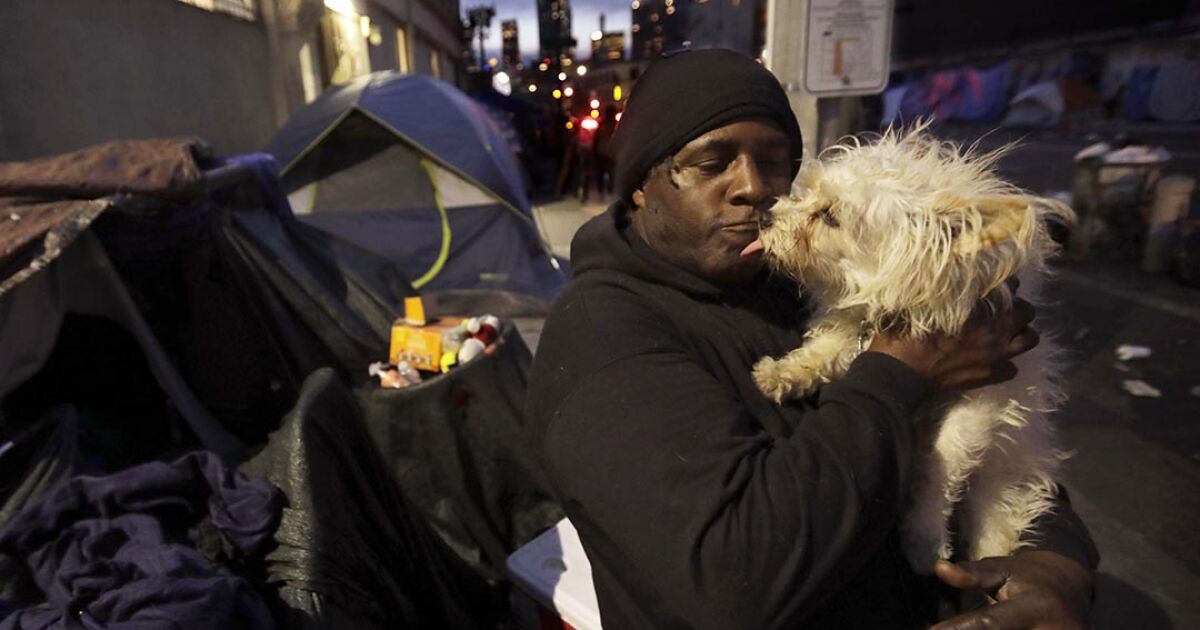 www.latimes.com
www.latimes.com
Public policy and common perception have long tied the road to homelessness with mental illness and drug addiction. But a new study out Tuesday — the largest and most comprehensive investigation of California’s homeless population in decades — found another cause is propelling much of the crisis on our streets: the precarious poverty of the working poor, especially Black and brown seniors. “These are old people losing housing,” Dr. Margot Kushel told me. She’s the lead investigator on the study from UCSF’s Benioff Homelessness and Housing Initiative, done at the request of state health officials. “They basically were ticking along very poor, and sometime after the age of 50 something happened,” Kushel said. That something — divorce, a loved one dying, an illness, even a cutback in hours on the job — sparked a downward spiral and their lives “just blew up,” as Kushel puts it. Kushel and her team found that nearly half of single adults living on our streets are over the age of 50. And 7% of all homeless adults, single or in families, are over 65. If that doesn’t kindle at least a bit of fear and empathy in your heart, you’re either a mogul or a trust fund baby who has never struggled to pay the bills. As much as we want to see the average homeless person as a drug tourist dropping into too-progressive cities for the good fentanyl and lax laws, as is the narrative in San Francisco, or someone whose mental illness makes it impossible for them to live unaided, the truth is simpler — and much more devastating: As Californians age, they are being priced out of housing. We have come to the point of income inequality that if you are older and unable to work, homelessness is a real threat throughout the Golden State. For every 100 extremely low-income people in California, defined as making less than 30% of area median income, there are only 24 units of affordable housing available. That makes obtaining and keeping permanent housing an ugly game of musical chairs, as the report puts it, in which too many are left standing when the music stops. “What people need to know is there are professionals on the street,” DeDe Hancock told me. She’s a member of the lived experience advisory council for the study. “People who are middle income are dropping to low,” Hancock said. “People working every day are living in cars.” Before becoming homeless in 2006, Hancock, who has a psychology degree from UC San Diego, owned both a home and a rental property. She lost her job as an administrative assistant at a nonprofit after pointing out a financial discrepancy, she said, and filed a wrongful termination complaint. But losing her job started that spiral that ended up with her losing both her properties. She and her son moved into her mother’s home, but within a few months, her mom died of pancreatic cancer. She ended up losing that property, too, when she couldn’t pay off a loan against it. One loss leading to the next. Her 12-year-old son went to live with his football coach, and she began sleeping in a storage unit where she was keeping the remnants of her lost life. But eventually she wound up on the streets, two weeks before Thanksgiving in 2009. She remained homeless for seven years until she was able to apply for early Social Security at age 62. “The sad thing is that in those seven years, no one ever asked me why or how I became homeless,” Hancock told me. And like so much of our inequality, race is a big factor — Kushel found that more than a quarter of those surveyed identified as Black, while only 6% of Californians overall are Black. Native Americans are also over-represented in our homeless population. Those facts are shameful and should change both the narratives we tell ourselves about the 171,000 people homeless in California and how we fix the crisis. That’s not to say that there isn’t also a crisis of mental illness on our streets, or that substance use isn’t a problem. Mental illness and substance use are clearly troubling pieces of the puzzle, as is the terrible job we do helping people re-establish themselves when they come out of our jails and prisons. The study found 1 in 5 of those interviewed became homeless after being incarcerated. A bit more than a quarter of the people Kushel’s team interviewed had a mental illness serious enough to require a hospitalization at some point in their lives — a sign of what we all know, that our mental health care system is unconscionably lacking. Which is why initiatives such as CARE Court are critical to providing an alternative path for those with severe mental illness. And though Kushel points out that the perception is that most people on the street are using drugs, “it’s not everybody,” she said. Only about a third said they were regular users of meth — the most common drug reported. But Kushel found that even for people with those other factors, financial instability was the tipping point. She discovered that many of the older people living on the streets were employed for most of their lives, often in physically demanding jobs such as waitressing, warehouse work or construction. The kind of jobs our economy depends on, where workers are easily replaced and often are. That was the case for Tony, a homeless man I met last week in Sacramento, who says he ended up in a tent after “a storm of bad luck.” He asked me not to use his last name, but he shared his story. He was born in the San Fernando Valley and went to Sacramento to be with a girlfriend. He had a job in transportation but lost his license over a traffic violation in 2018 that he never cleared up. Then he broke up with the girlfriend and had to move out of her apartment. “After you lose your job, you lose everything,” he told me, standing under a line of shady sycamore trees on a road that divides a rich neighborhood from one filled with encampments. “There’s too much money on one side [of the street] and not enough on the other,” he said. The study used eight counties throughout California, including Los Angeles, to create a snapshot of both rural and urban homelessness — surveying nearly 3,200 people and conducting 365 in-depth interviews. Researchers found that the results held regardless of whether a person was without housing in one of our large cities, or in our less-populated northern and eastern counties. Kushel and her team also found another myth-dispelling fact: Most of the homeless people on California‘s streets are Californians. While conservative pundits love to scream about lazy homeless people flocking to the state for easy living, “we have to stop these narratives that people are flooding into California,” Kushel said. “It’s not true.” Kushel found that 9 out of 10 people lost their last housing in California and three-quarters live in the same county as where they most recently had a place to call home. And a side note: Does compassion require a specific ZIP Code? Most of the money cities and counties are using for housing and homelessness comes from the state and the federal government — not local coffers. Those dollars do not come with where-are-you-really-from strings. Kushel said her findings should be a wake-up call that while access to substance use treatment and rebuilding the mental health care system are urgent for some of the homeless population, the only solution to homelessness is housing. We have to build not just affordable housing, but housing for extremely low-income folks, she said. And we have to do better at keeping people in the housing they have, through rent subsidies and other direct intervention, when life punches them in the face. Because as fast as we can pull people out of homelessness, the rent is too high and more and more people can’t pay it. She found in the six months prior to their being homeless, people’s average income was $960. So impoverished people need stable housing — which is the starting point L.A. Mayor Karen Bass is using, to her credit. My colleagues Ruben Vives and Doug Smith recently reported that during her first six months in office, Bass has found permanent housing for more than 4,300 people living on the streets and interim housing for thousands more. Her plans may be imperfect, but they have the right goal. Meanwhile, in San Francisco, Mayor London Breed has initiated a crackdown in the troubled Tenderloin that entails arresting folks for crimes including public intoxication, dragging them into custody for a few hours, then tossing them back on the street. Not a single person detained has accepted offers of treatment so far — unsurprising since incarceration is not a huge trust-builder. That kind of short-term fix drives people farther into the margins, Kushel warned, making them invisible but no less in need. The last statistic I will give you is this: Fewer than half of people living on the streets have received formal help obtaining housing. Despite all our efforts, there is a massive disconnect between how much intervention the government perceives it is offering and how much is actually reaching people, Kushel said. Though the reasons for that are unclear, she said it may be in part because aid is focused on shelters or troubled encampments and misses the quiet, hidden homeless. That is the case for Ivan Dixon, 53, whom I talked to in an alley in Sacramento. He’s been homeless since his father kicked him out at age 14, he said, living with a group of underground hip-hop dancers until he aged out of that scene. When I asked him if he wanted housing, he looked at me as if I was stupid. “Of course I do,” he told me. But he said being homeless means you are “nobody’s friend.” He has not been offered help, he said. But he also tries to avoid people — moving every night to avoid becoming a “target” of both violence and the police. “That’s just being in the streets,” he told me. But it’s no life for an old man.
 www.latimes.com
www.latimes.com
The Clippers are on the clock. They have upcoming deadlines to decide whether to guarantee next season’s contracts for guard Eric Gordon, which becomes guaranteed June 28, and two of their picks from the 2021 draft in wing Brandon Boston Jr. (June 30) and guard Jason Preston (July 2). They have holes at backup center and starting point guard and are interested in filling the latter by re-signing unrestricted free agent Russell Westbrook or making a play for Chris Paul, whether by trade with Washington or as a free agent if his contract is bought out by the Wizards. In broader terms, with the NBA’s new collective bargaining agreement, and its onerous restrictions on top-spending teams like the Clippers, taking effect July 1, they have to thread the needle of positioning themselves for a championship run next season without compromising their ability to remain a compelling ticket with title aspirations once the team moves into its new Inglewood arena, Intuit Dome, in 16 months. League observers are watching how much of their future payroll the Clippers would like to commit to contract-extension eligible stars Kawhi Leonard and Paul George, their All-NBA-caliber pillars who have struggled to remain healthy in the postseason. Most immediately, the Clippers have draft selections to make. They hold the 30th and 48th picks in the NBA draft Thursday. History suggests those decisions won’t be the only ones their front office makes. The Clippers made at least one trade on draft night every year from 2015 to 2021. The Clippers do not publicize the names of prospects they host at their practice facility in Playa Vista but have brought in a wide range of players for either group workouts, individual workouts or meetings. Though not an exhaustive list of every prospect hosted by the team, people with knowledge of the Clippers’ pre-draft interest who requested anonymity because they’re not authorized to speak publicly about them did confirm a number of prospects who have met with the team. Guards have included Wichita State’s Craig Porter Jr., UCLA’s Tyger Campbell, Texas Christian’s Mike Miles Jr., Oklahoma’s Grant Sherfield, Kansas State’s Markquis Nowell, Miami’s Isaiah Wong and Santa Clara’s Brandin Podziemski. Wings have included Kansas’ Jalen Wilson, Marquette’s Olivier-Maxence Prosper, UCLA’s Jaime Jaquez Jr., Penn State’s Seth Lundy, San Jose State’s Omari Moore, Tennessee’s Julian Phillips, Belmont’s Ben Sheppard, Arkansas’ Jordan Walsh and Ohio State’s Brice Sensabaugh. Sheppard and the Pasadena-raised Moore also worked out for the Lakers on Tuesday, one day after doing the same for the Clippers. Big men have included Alabama’s 6-foot-10 Noah Clowney and Washington State’s 6-11 Mouhamed Gueye. In win-now mode, the Clippers don’t need their newest selections to immediately shore up coach Tyronn Lue’s rotation. The bulk of last season’s rotation is already under contract, and that doesn’t include Boston, who has spent the majority of his first two seasons playing in the G League but could be in line for more pathways to playing time as an aging roster attempts to develop younger contributors. With most of the team’s playing time already allocated to returning players, it has led the Clippers in the past to taking on players considered “projects” who can be developed with future seasons in mind. Last year, they held firm in the second round to take forward Moussa Diabate, who impressed while earning all-rookie honors in the G League last season.
 www.latimes.com
www.latimes.com
A week after being rocked by public corruption allegations against yet another one of its members, the Los Angeles City Council regrouped Tuesday, electing Councilmember Marqueece Harris-Dawson to serve as its next president pro tempore. The council’s No. 2 role was previously held by Councilmember Curren Price, who stepped down from the position last week after being charged with perjuring himself by failing to disclose his wife’s business dealings with developers whose projects he voted on, and with embezzling city funds by having his now-wife receive spousal health benefits when they were not legally married. Speaking to reporters shortly after the vote, Harris-Dawson called the situation facing Price “unsettling.” Harris-Dawson also said the case has left him and others “scratching their heads.” “It’s just unclear. I’ve not seen a felony charge for this type of activity. I’ve seen ethics violations for this type of activity,” Harris-Dawson said. “So it leaves me curious.” Ethics Commission cases are handled administratively, with financial penalties issued for those who violate financial disclosure and conflict-of-interest laws. The district attorney’s office files criminal charges. Harris-Dawson appears to be the first council member to publicly express concerns about the case against Price, which is made up of 10 felony counts: perjury, embezzlement and violations of the state’s conflict-of-interest law. Much of the case focuses on votes cast by Price on affordable housing projects developed by companies that employed Price’s wife as a consultant. Asked about Harris-Dawson’s comments, a spokesperson for Dist. Atty. George Gascón said the office filed criminal felony charges against Price because “the alleged actions are defined by law as a crime.” If the D.A.’s office had found that violations of civil law had occurred, but that no crime had been committed, it would have referred the matter to the city’s Ethics Commission or the state’s Fair Political Practices Commission, said Tiffiny Blacknell, the director of Gascón’s bureau of communications. Price has previously called the charges “unwarranted” but has not provided a more vigorous rebuttal. Harris-Dawson is also a member of the council’s rules committee, which is scheduled to take up a proposal to suspend Price on Friday. Harris-Dawson declined to say whether he thinks Price should be suspended. Tuesday’s pro tempore election was conducted with little fanfare. After the council unanimously approved more than 20 matters before them with a single vote, council President Paul Krekorian’s face lit up as he asked the clerk to clarify that the pro tempore vote was included in the list. “With that vote, I’m pleased to congratulate our council President Pro Tem Marqueece Harris-Dawson,” Krekorian said soon after, as Harris-Dawson smiled and raised his clasped hands with a slight bow. “I’d like to ask you to come on up and take the desk.” After walking up to the raised dais where the council president sits, Harris-Dawson spent the next 20 minutes presiding over the meeting. It’s a role he will now fill whenever Krekorian is absent. Krekorian had initially put Harris-Dawson’s name forth for the role last week and was not met with any public opposition on the council. The shakeup will not dramatically alter the council, but it does put Harris-Dawson in a prime position for further political ascent. The South Los Angeles council member and former community organizer has been eyeing the council presidency, which will be vacant again late next year when Krekorian terms out. Harris-Dawson is also particularly close to Mayor Karen Bass. He ran Community Coalition, the progressive South L.A. nonprofit organization that Bass founded, before joining the council. Harris-Dawson’s former chief of staff, Solomon Rivera, recently left the council office to join the mayor’s administration. He represents the 8th District, which is considered the heart of L.A.’s Black community. Along with Price, Harris-Dawson is one of only two elected Black members on the council. (A third member, Heather Hutt, was appointed by the council to fill former Councilmember Mark Ridley-Thomas’ seat.) Although the president pro tempore is elected by his or her peers, rather than directly chosen by the council president, he or she is still part of the council president’s leadership team. The pro tem can “provide critical strength for a leadership coalition in the council,” said Raphael J. Sonenshein, executive director of the John Randolph Haynes and Dora Haynes Foundation, which sponsors social science research on Los Angeles. Harris-Dawson leans politically to the left of Krekorian and has strong relationships with the council’s most progressive members. Those connections could be a boon to Krekorian as the council president seeks to corral votes.
 www.latimes.com
www.latimes.com
A court-appointed doctor has determined that Carlos Reales Dominguez, a former UC Davis student charged with killing two men and wounding a woman in a string of stabbings that shocked the quiet college town, is not mentally competent to stand trial for those crimes. Yolo County Superior Court Judge Samuel McAdam announced the finding during a court hearing Tuesday. Prosecutors in the case took issue with the finding and requested a jury trial on the question of Dominguez’s competency, the Davis Enterprise reported. McAdam set the hearing for July 24. “I want to apologize and say I’m guilty,” Dominguez, 21, said in court Tuesday before his public defender, Dan Hutchinson, asked for a brief recess. McAdam ordered that the confession be struck from the record. Dominguez is charged in a series of seemingly random stabbings carried out over a period of days in late April and early May. Two of the attacks occurred in local parks, casting a pall over a city that celebrates its green space, youth sports and outdoor markets. Dominguez pleaded not guilty at his May 5 arraignment. Dominguez was first detained on May 3. Police stopped him near the scene of one of the killings after several Davis residents called police to say he matched a description provided by witnesses to two of the attacks. The first attack was discovered April 27, when authorities found the bloodied body of 50-year-old David Henry Breaux, a Stanford University graduate who chose to live outdoors and often spent nights in Davis’ leafy Central Park. Breaux had been stabbed to death on a bench where he slept. Two days later, Karim Abou Najm, 20, a UC Davis senior and Davis High School graduate, was fatally stabbed in Sycamore Park as he biked home from a university event. A neighbor heard sounds of distress and came to Najm’s aid but wasn’t able to save him. Days later, a woman in her 60s was attacked as she slept at a homeless encampment near the city’s downtown. She was alone in her tent when her assailant slashed the canvas, reached in and stabbed her repeatedly. She was hospitalized but survived. When police detained Dominguez, they said they found a large “hunting-style knife” in his backpack. Davis Police Chief Darren Pytel said investigators spoke with Dominguez for hours before arresting him for all three crimes. After the arrest, UC Davis officials said that Dominguez had been “separated” from the school for poor academic performance less than two days before the violence began. Dominguez, who came to the U.S. from El Salvador as an unaccompanied minor in 2009, was an accomplished student and athlete at Castlemont High School in Oakland. He graduated in 2020 and enrolled at UC Davis. After his arrest, his father expressed shock in a brief phone interview with The Times: “He was so excited to go to Davis. I don’t understand how this could happen,” the father said. The violence cast a chill over life in small-town Davis. People were afraid to go out at night, and businesses closed their doors early. Community members openly mourned the deaths of two gentle and well-loved residents. After the hearing Tuesday, Abou Najm’s mother, Nadine Yehya, told the Davis Enterprise that she “couldn’t stop myself from crying” when she heard Dominguez’s confession in the courtroom. She and her husband, Majdi Abou Najm, have dedicated themselves to efforts to honor their son’s life, including an initiative for research into mental health and better interventions to help people before they commit terrible acts. On Sunday, the family attended what would have been Abou Najm’s college graduation ceremony.
Everybody, Leimert Park is hoppin' and it's right by the lovely k line! Should check it out
 www.latimes.com
www.latimes.com
“Los Angeles City Councilmember Curren Price was charged with 10 counts of embezzlement, perjury and conflict of interest on Tuesday, becoming the latest in a years-long parade of elected city officials to face public corruption allegations from state or federal prosecutors.” Haven’t seen this shared since the sub re-opened, if it’s a repost please take it down. Price’s charges makes him the fourth Councilmember to be arrested in the past four years, along with Mark Ridley-Thomas, Mitch Englander and Jose Huizar.
It's already the middle of June but we're averaging low 70F.



